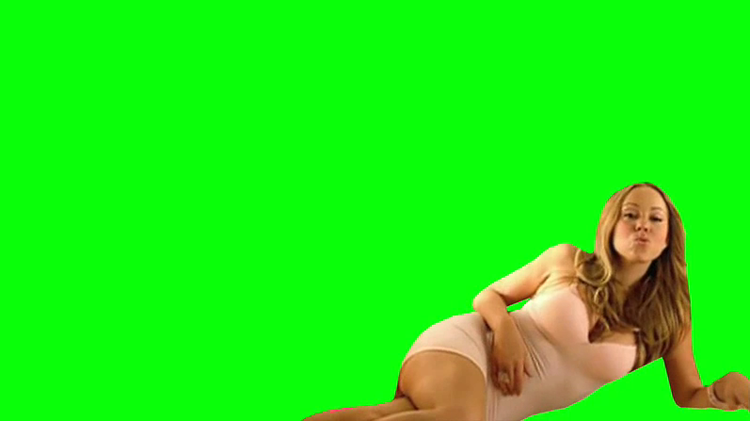Oliver Laric, Touch My Body, Green Screen Version, 2008 and The Marble Player, From the series Lincoln 3D Scans, 2013
Oliver Laric uses memes, movable type, copies and collective agency to make art that is only partly ‘his.’ Oliver Laric once showed a 16th-century print by Flemish court artist Marcus Gheeraerts the Elder. The etching depicts a scene of iconoclasm, or Beeldenstorm, during the Reformation, when churches and public spaces in northern Europe were systematically purged of religious imagery, often by mobs. Hallucinatory in its detail, the print shows a swarm of figures on a mount pillaging icons, breaking statues, tossing altarpieces into a fire. Birds in the air shit on monks beside bare trees that crown a bald outcropping; broken relics and shattered crucifixes jut out like gravestones from a pit.
Gheeraerts’s work isn’t simply a depiction of image breaking. When viewed from afar, the mass of active figures in the print forms a new, anamorphic image: a grotesque, composite illusion of a monk’s rotting head. An assembly of small bodies forms a sagging mouth (full of drunken townsfolk), and a group of monks ploughs a field that’s also the head’s wrinkled brow; a monkey stands inside an ear, and the figure’s nose is formed by a crucifix about to be toppled between two hollowed-out eye sockets.
I don’t think Laric had ever seen the real Allegory of Iconoclasm (c. 1560–70) – which exists only as a smallish, unique print in the British Museum – when he introduced me to Gheeraerts’s work during a conversation about his own video Versions (2012), the third in his series of that name, in which the monk’s head appears briefly. I write ‘real’, although Laric’s information-driven videos and sculptures confound distinctions between real and fake, even making that effacement their subject. I write ‘own work’, despite Laric’s ongoing concern with the mutability of authorship and ownership. An author is fungible, particularly as enabled by recent forms of collective and participatory labour. Internet memes, popular and children’s films, super-cut YouTube videos, medieval sculptures, outsourced remakes and the ‘participatory’ labour practices of North Korean monuments are all found, re-remixed and translated in Laric’s works. And although I write ‘conversation’, that word only partially accounts for the hopscotching, hyper-medial surge of links, flickering images and n+7 web results that the artist retrieves, combs through and reassembles to display and comment on his own material, as well as that of others. ‘I sometimes Google terms that seem to have nothing to do with each other,’ Laric says. ‘“Mikhail Bakhtin and prosumer” or “Samuel Beckett and Teletubbies”. Usually, there’s an unexpected link.’ In the latter case, it might be Beckett’s Quad (1981), whose four actors could be proto-Teletubbies; in the former, it’s Bakhtin’s dialogic understanding of how production oscillates between collectives and individuals – a dialectical motor Laric puts to work in his collectively-based pieces.
There is no distinction between the material Laric finds and that which he presents as his own. Laric’s exhibition ‘Kopienkritik’ (Copy Critique) at the Skulpturhalle in Basel in 2011 took its cue from the 19th-century methodological approach to philology and ancient sculpture, which viewed (inferior) Roman ‘copies’ in terms of (superior) Greek ‘originals’, reconstructing those lost originals via the bulk typologizing of inferior later copies. Laric cast and grouped that museum’s collection of Greek and Roman plaster casts into typologies, alongside video monitors and heads cast by the artist. ‘Copyright did not exist in ancient times, when authors frequently copied other authors at length in works of nonfiction.’ This declaration does not come from a history of literary influence, but from the GNU Manifesto, written by MIT’s Richard Stallman in 1985 to announce an influential, free software, mass collaboration coding project (and the theoretical backbone to much open-source digital content today). ‘Be promiscuous,’ reads an Open Source Initiative manifesto encouraging coders to distribute their works free of charge. Laric draws on this ethos of collective reworking.
Although you can find it on YouTube, Laric’s Touch My Body: Green Screen Version (2008) is not really a video but rather a participatory game, or dare, that Laric intended to be appropriated and modified. For Touch My Body…, Laric stripped Mariah Carey’s music video for her 2008 song of the same name of all but Carey herself, and replaced it with a green screen, against which any background could be inserted. When Laric posted the piece to YouTube that year, users took the cue and began uploading amateurish, witty remixes using Laric’s template. (Including one with a background of zombie gore taken from Sean of the Dead, 2004). Today, the first result when searching for Laric’s piece on YouTube is not his original video, but an amateur mash-up, of which there are many.
Memes – like fame, lies and capital – accrue value and cachet as they circulate. But they also date and flatten, and while Touch My Body … lacks the complexity of Laric’s later pieces, it demonstrates the atmosphere in which his work arose: the newly ‘social’ internet; the advent of the ‘prosumer’ (‘producer-consumer’ or ‘professional-consumer’) technology that enabled easy editing by 15 year olds; online video-sharing platforms; freely accessible, though commercial, image repositories such as Getty Images and Flickr. On a larger scale, the points of departure for Laric’s works have been incipient shifts in group structures and collective agency (shifts not limited to the internet), the global political atmospheres of what in the mid-2000s began to be called ‘truthiness’: a simultaneous reliance on, and distrust of, circulated images and narratives.
The striking succession of historical images that opens the first of Laric’s essayistic video series ‘Versions’ (2009–12) is as much a comment on political shilly-shallying as an assertion of the masses’ new claim on image production and circulation. The video, which is a trove of examples of the fraught status of reproductions and copies from recent and contemporary material culture, begins with an image (released by Iran’s state media to Agence France-Presse in 2008) of four missiles, which was used to illustrate Iran’s missile tests when it appeared on the pages of the Los Angeles Times and the Financial Times, among many others; following this, Laric inserts a graphic that indicates how that image was clearly manipulated, if not fabricated, using Photoshop (the multiple missiles are effectively copy-and-pasted from within the image). And finally, a series of user-generated spin-offs of the Photoshopped image showing dozens of missiles, their streams in comic curlicues. I can’t think of any better way of exemplifying Jean Baudrillard’s ideas about simulacra and hyperreality in our age of truthiness than this simple slideshow compiled by Laric.
Until a few years ago, the internet was the main (and often only) way to see Laric’s works, and those of sanctioned fellow artists. Before I ever heard of him, I would often look at VVORK.com, the influential blog he ran from 2006 to 2012 with Aleksandra Domanović, Christoph Priglinger and Georg Schnitzer. The set-up was simple: an art work or two posted daily, either by one of the four founders or (usually) by another artist. VVORK would ‘curate’ not only images of contemporary works but also historical ones, predating that now-orthodox usage of Tumblr, and still contrasting with exhibition-based blogs like Contemporary Art Daily. On a random day in 2009, these posts might include a 2001 tray installation by Brian Jungen, a 2009 work by Markus Schinwald, a 1967 piece by Les Levine, and the ‘Silhouettes’ series (Untitled) by Seth Price, whose 2002/2008 essay ‘Dispersion’ continues to be one of Laric’s conceptual cornerstones. Laric believes – like Price, and as Marcel Broodthaers is quoted as saying at the beginning of the ‘Dispersion’ essay – that ‘artistic activity occurs, first of all, in the field of distribution’.
Laric, whose first solo show in Berlin was in 2012, says that ‘for many artists, distributing images of their works online happens secondary to physical exhibition. For me, the online distribution happened first.’ Distribution is the aim and theme of his recent Lincoln 3D Scans (2013) – the result of his receipt of the Contemporary Art Society Annual Award – for which he is 3D scanning and publishing 3D models of the complete holdings of the Usher Gallery and The Collection in Lincoln, to be used in an unknown fashion, for free, and for any reason – whether advertising, garden decoration, scholarly research or design. Despite the expense and technological expertise required for such a task, Laric is driven by a bootleg, Samizdat-like stance, shared by other artists working with the internet as medium, one with art-historical roots in conceptual art’s blurring of documentation and event, work and distribution, as well as in the history of design.
More particular to Laric’s work is how this axiomatic stress on self-dispersion is also an attempt by the artist to self-efface, to swamp the ego in an ocean of collectivity. Viewed from a distance, this attempt is the allegorical gist of Laric’s entire project. Above all, it’s the ambiguities of invisible labour that Laric explores. This concern is also perceptible in his discrete objects: the 3d printed sculptures of Reformation-damaged Icons (Utrecht, Worcester, 2009), or the 2013 ‘everyman’ statuette Laric commissioned from the North Korean Mansudae Overseas Projects, a factory in Pyongyang specializing, controversially and rather terrifyingly, in creating communist ‘realist’ kitsch monuments.
http://www.frieze.com/issue/article/iconoclash/
http://www.magazinecontemporaryculture.com/oliver-laric/

